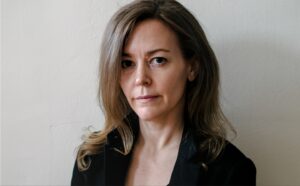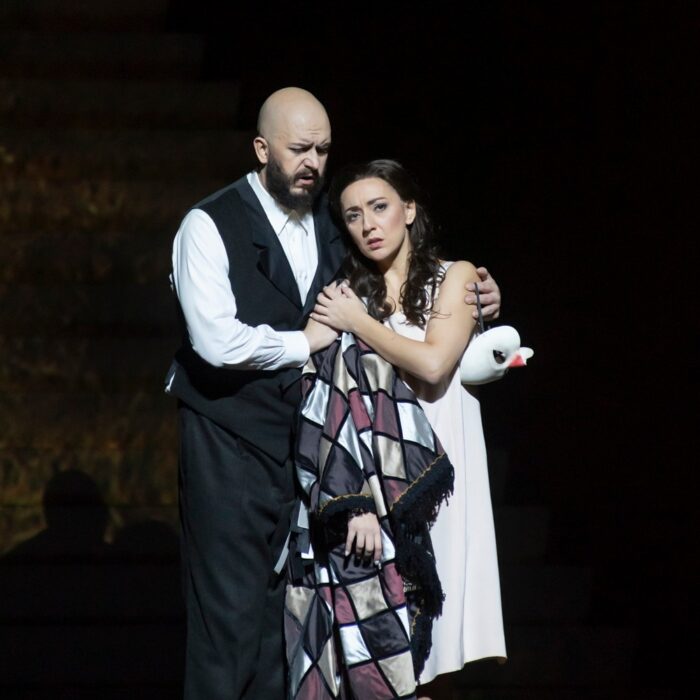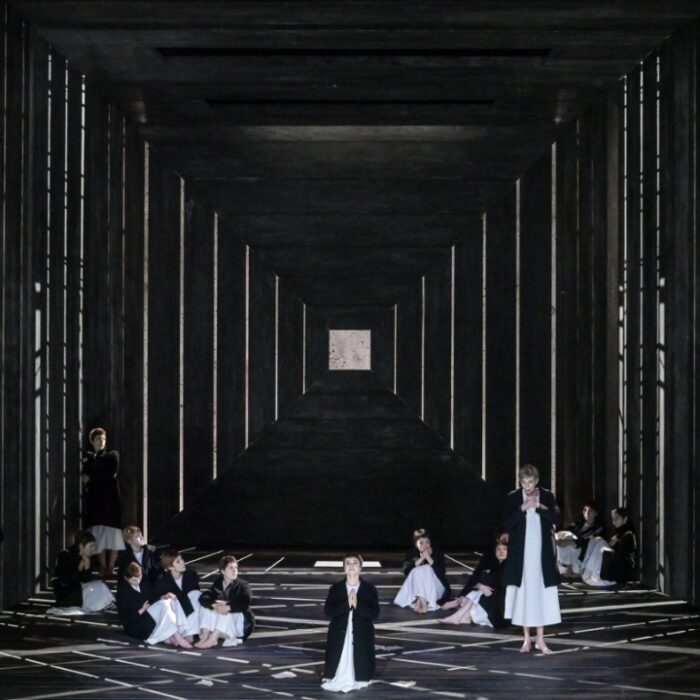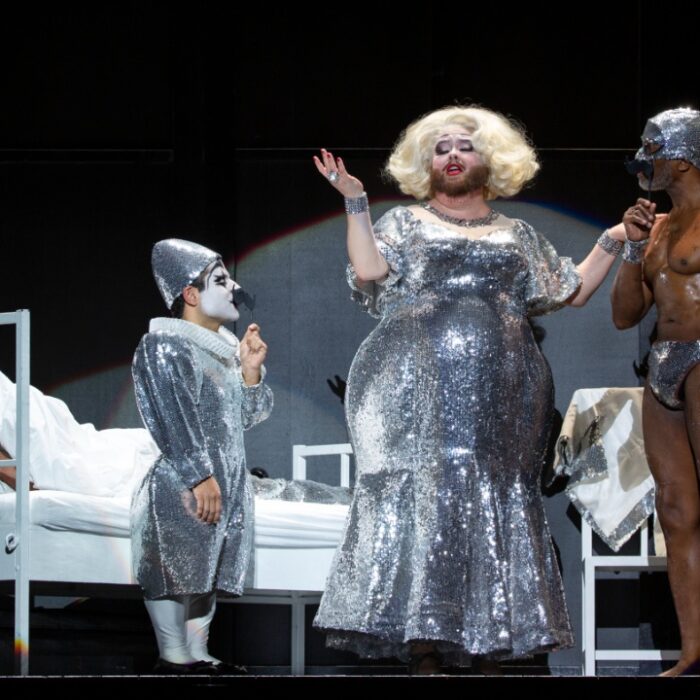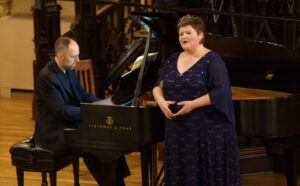
Brooklyn Art Song Society 2023-24 Review: Circles II – The Wagnerians
Exploring Wagner’s Musical Influence Through the Prism of Transcendence
By Jennifer PyronPhoto credit: Catherine Hancock
Brooklyn Art Song Society (BASS) continued its 14th season with “Circles II: The Wagnerians” on Friday, November 3rd, 2023, at the First Unitarian Church of Brooklyn. OperaWire covered its season opener, “Circles I: Clara, Robert & Johannes,” last month and discovered how art song continues to engage listeners from a place of uninhibited curiosity and what BASS’ artistic director Michael Brofman calls “divine mystery.”
While reading the notes about the evening’s Wagner-based series and recalling information about Richard Wagner’s political affiliations and life work, one might have been interested in attending this series to see how Brofman would spin such a combination of composers, including Duparc, Chausson, and Wolf. “Richard Wagner is possibly the most polarizing figure in all of Western Music. In his life and until today, he’s only evoked the deepest admiration or hatred and rarely anything in between,” said Brofman.
However, it seemed that Brofman had not only prepared elements of surprise within his historical connections, but also managed to choose the most beautifully potent art songs to illustrate this level of connection between each featured composer. It also helped to have Professor Larry Wolff from NYU go into detail about his historical understandings in a pre-lecture before performances began.
“Both Duparc and Chausson cite their first encounters with Wagner’s music as turning points in their lives. Duparc met the composer in 1870 and kept correspondence with him for the next 15 years (sadly, Duparc burned these letters along with countless drafts in a fit of depression in which the composer swore off composing for life.) Chausson traveled to Bayreuth in 1882 to hear the premiere of ‘Parsifal’ and recounted it as akin to a religious pilgrimage. Both men integrated many of Wagner’s music techniques into their works, especially their Melodies. The two composers’ affinity for Wagner was a large part of their deep friendship. From tonight’s program, Duparc’s ‘Phidylé’ is dedicated to Chausson, and Chausson’s ‘Les Temps de Lilas’ is dedicated to Duparc,” said Brofman.
“On the other hand, one of the most vocal supporters of Wagner was a young music critic and composer by the name of Hugo Wolf. Although Wolf is most known for his over 400 lieder written in just over a decade, his true aspiration was to be an opera composer in the Wagnerian tradition. However, these ambitions were dashed when his first opera ‘Der Corregidor’ was a disastrous failure (the opera is rarely performed today, but some arias were converted into songs included in the Spanische Liederbuch). Wolf never returned to opera; instead, he focused his energies applying Wagnerian techniques to Lieder,” said Brofman.
The main takeaway that felt like a recurring theme throughout the evening was the idea of Wagner’s “unity.” “If one were to sum up Wagner’s musical thinking in one word, it would be unity. It began with the through-composed nature of his musical voice – ‘endless melody,’ which would ebb and flow seamlessly between melody and quasi-recitative for hours at a stretch (‘Das Rheingold’ still holds the record for the longest work of uninterrupted music at nearly three hours),” said Brofman.
And so, while keeping this idea of unity and ultimately transcendence at the forefront of one’s mind, “Circles II: The Wagnerians” developed into a musically inspiring and refreshing experience.
Henri Duparc
Baritone Mario Diaz-Moresco and pianist Spencer Myer began the evening’s performances with Henri Duparc’s lieder. “La vague et la cloche (The wave and the bell),” text by librettist François Coppée, requires a guttural swell of emotions that Diaz-Moresco’s voice naturally emanated. His vocal technique was aligned with his delivery, and what could’ve been an overly emotional beginning most certainly was not. Diaz-Moresco innately understands the refined approach it takes to do Duparc’s music justice. He was both grounded and secure in this knowing, especially while singing, “Puis tout changea… la mer et sa noire mêlée, sombrèrent… sous mes pieds s’effondra le plancher de la barque, (Then everything changed. The sea and its black tumult subsided. Beneath my feet the floor of the boat gave way).” Myer’s piano playing was also right on course with Diaz-Moresco’s interpretation. The two made this first lieder into a storytelling fantasy of harsh reality. “Pourquoi n’as-tu pas dit, ô rêve, où Dieu nous mène? Pourquoi n’as-tu pas dit s’ils ne finiraient pas, L’inutile travail et l’éternel fracas Dont est faite la vie, hélas! la vie humaine! (Why did you not say, O dream, where God leads us? Why did you not say if they will ever end, The fruitless toil and the endless strife Of which human life, alas, is made?)” Diaz-Moresco’s voice carried this message into the ethereal realms where souls reside.
Duparc’s “Extase” with text by librettist Jean Lahour was an interesting followup to “La vague et la cloche.” The slower tempo was quite noticeable in that it gave listeners a moment to pause and reflect. “Extase” illuminates a lover’s bliss, and Diaz-Moresco’s voice seemed to melt into the sub-context beyond this obvious telling. His purposefully detached and observant approach to this lied was very much appreciated. At this moment, Diaz-Moresco illuminated the theme of the evening — Wagner’s unity.
“Le manoir de Rosemonde” was an excellent choice for Diaz-Moresco’s rich vocals and savory French diction. The text by librettist Robert de Bonnières reveals haunting imagery, and paired with Spencer Myer’s piano playing, this lied was a satisfying treat to experience live and in the intimate space of the church. The wooden pews resonated the booming, impending doom of the phrase “Et qu’ainsi je m’en fus mourir Bien loin, bien loin, sans découvrir Le bleu manoir de Rosemonde (And that thus I went off to die Far, far away, without ever finding The blue manor of Rosamonde.)”
“Phidylé,” with text by French poet Charles-Marie-René Leconte de Lisle, was the final song of the evening’s Duparc section. Dedicated to his friend Ernest Chausson, “Phidylé” is emotionally stirring. Wagner inspires the gentle build-up into a climactic arch; however, what makes this mélodie very Duparc is the underlying connection to Chausson. Supposedly inspired by Gabriel Fauré’s mélodie “Lydia,” which is also based on a poem by Leconte de Lisle, “Phidylé” references Duparc’s personal aesthetic apart from Wagner and Fauré’s influence. Ultimately, it is “Phidylé” where Duparc’s most intimate thoughts are brought to life, and as Diaz-Moresco’s voice highlighted best, “Qui, dans les prés en fleur germant par mille issues, Se perdent sous les noirs halliers, (That flow in flowering meadows from a thousand sources, And vanish beneath dark thickets.)”
Ernest Chausson & Hugo Wolf
Mezzo-soprano Blythe Gaissert and pianist Dimitri Dover performed a combination of Chausson and Wolf lieder. “Les temps des lilas” began with its very indulgent opening piano melody and vocal line. Listeners were transported at that moment. Gaissert’s voice blossomed into a thought-provoking opportunity for listeners to study the beautiful combination of voice and piano that Chausson is absolutely admired most for in his compositions. Chausson’s nostalgic mélodies do something to the heart whenever one listens to them. It was with great pleasure that I experienced both “Les temps des lilas” and “La caravane” live together.
From Hugo Wolf’s “Mörike Lieder,” Gaissert and Dover performed “Gesang Weylas,” “Begegnung,” and “Verborgenheit.” Gaissert’s voice glided over the most complicated moments of French diction, and Dover’s piano playing felt alive and urgently aware in a refreshing way. “Verborgenheit (Seclusion)” was an especially outstanding moment of Gaissert’s performance. In this, Gaissert sang from an internal place of conviction and resolve. One might have closed their eyes to capture the palette of vocal colors at that moment fully. “Oft bin ich mir kaum bewusst, und die helle Freude zücket durch die Schwere, so mich drücket wonniglich in meiner Brust (Often, I am lost in thought, and bright joy flashes through the oppressive gloom, bringing rapture to my breast).” was brilliant in Gaissert’s voice.
Baritone Brian James Myer and pianist Dimitri Dover also performed portions of Wolf’s “Mörike Lieder,” including “Auf einer Wanderung,” “Im Frühling,” “Der Jäger,” and “Der Feuerreiter.” Myer’s expressivity and close attention to French diction made it easy for any listener to interpret his storytelling. “Der Feuerreiter,” “Fire-Rider,” was riveting in Myer’s voice. The audience was on the edge of their seats to watch and listen to Myer the entire time. Dimitri Dover’s piano playing was exquisite in this lied as well.
Richard Wagner
Soprano Tami Petty and pianist Spencer Myer’s performance of Wagner’s “Wesendonck-Lieder” was breathtaking. Listeners were enamored with Petty as her voice unfurled into a glorious body of ethereal highs and captivating lows. Her middle range’s vitality supported the full spectrum of her voice and highlighted this as necessary to excel vocally through a song cycle. In this way, her vocal technique captivated the listener’s ear, as it was the most natural thing for her to do — emanate the true meaning of Wagner’s unity. Tami Petty’s voice was revelatory.
The opening lied, “Der Engel,” has a moment where the soprano’s voice first becomes most exposed in its upper range and foretells from that point how the remainder of the cycle will develop. “Und es sani gen Himmel hebt (And gently raise the heart to heaven)” is this moment. When Petty voiced “Himmel hebt,” the transparent wonder that is “divine mystery” came forward. The neck and arm hairs of anyone in the audience might have been awakened. For this was when one could freely breathe, hold on to a beautiful thought, and dream.
There are moments when special connections happen in this way, including observing a flower stretch into full bloom or a silent ray of sunshine make its way through the window to greet a new day. Very rare does this level of profound brilliance come forward so effortlessly in a live performance, specifically through the voice and from the very bones of a composition’s worth. Tami Petty rose to this intimate occasion and created a way for listeners to, as BASS does best, revel in the infinite passion and power of art song cycles. For some, Wagner has never sounded this transcendental until now.
“Im Treibhaus (In the Greenhouse)” has a particular opening that remains unforgettable for any pianist. When Spencer Myer played this, it was like the entire church turned its head to watch and listen. One may forever cherish how pure and soulful these few notes were played through the hands of Myer. Everything became still and open — another moment of Wagner’s undeniable unity was made present and known. “Schweigend neiget ihr die Zweige, malet Zeichen in die Luft (Silently you bend your branches, inscribe your symbols on the air)” resonated warmly in Petty’s soprano. “Im Treibhaus” was definitely the most memorable lied of this evening’s series.
“Schmerzen” was another highlight in Petty’s voice when she elegantly crafted the text “Und gebieret Tod nur Leben, geben Schmerzen Wonnen nur: o wie dank’ich daß gegeben solche Schmerzen mir Natur (If only death gives birth to life, if only agony brings bliss: O how I give thanks to Nature for giving me such agony!)” Her final note hung in the air as it spun out and into listeners’ minds. This idea of unity was developing into something palpable and worthy of delight.
“Träume (Dreams)” completed the captivating close of Tami Petty’s interpretation of Wagner’s “Wesendonck-Lieder.” This lied also has special significance, as it bears the roots of “Tristan und Isolde’s” love duet in Act two. It is also important to note how this song cycle, composed in 1857-1858, features poems written by Mathilde Wesendonck, who was only credited for her work after she died in 1902. It is a tragic reminder of the oppression of female voices during a time when so many art songs developed into opera ideas and continued success. One might have felt extra grateful to hear Tami Petty interpret Wesendonck’s poems with grace and timeless inspiration — unity’s truest gift to us all.
